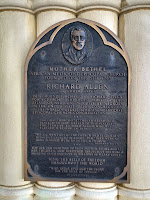Not all of Philadelphia's history is related to colonial history or the history of America's early government. There's much more to see.
For example, one of America's most historic prisons is open for visitors, the Eastern State Penitentiary (https://www.easternstate.org/ ). It opened in 1829, and it represented a radical new approach to incarceration. The architecture of the prison itself was innovative, designed like a wheel with seven spokes, allowing guards to keep an eye on the hallways from a central location. In the beginning, the way the prisoners were treated was based on the philosophy of isolation. The idea was that prisoners should be confined separately to allow for self-reflection and to prevent them from falling under bad influences. Prisoners were kept in single cells, each one with a small walled off outdoor exercise yard, and whenever they left their cells, they were masked. This solitary confinement system became known as the "Pennsylvania system" and influenced penal systems around the world before it was abandoned in 1913. ESP itself continued as a prison until 1971, housing more than 75,000 prisoners, including some famous inmates like Al Capone. It's a really interesting, and eerie, site to tour during the day, and they offer night tours during the summer as well.


Located near Independence Hall is the National Museum of American Jewish History ( https://www.nmajh.org/ ) established in 1976, the only museum in the country dedicated "to exploring and interpreting the American Jewish experience." The museum has a collection of over 30,000 artifacts, from the colonial period to the present day, that are used to create enlightening exhibits.
By Beyond My Ken - Own work, CC BY-SA 4.0, https://commons.wikimedia.org/w/index.php?curid=26378465
Belmont Mansion (https://www.belmontmansion.org/index.html ), built in the mid 1700s, is a historic mansion that hosted such illustrious guests as George Washington, John Adams, Thomas Jefferson, and James Madison. In the 1800s, the heirs of the builder were prominent abolitionists, and they allegedly played a role in the Underground Railroad. Philadelphia had quite a number of abolitionist groups, and it was a prominent terminal, the home of many free blacks and escaped slaves. Since 2007, a museum dedicated to the history of the Underground Railroad has occupied the mansion. Honestly, I wouldn't say that it's a must-see, but if you have time, go for it.
For black history in Philadelphia, I would recommend Mother Bethel AME Church (https://www.motherbethel.org/ ), founded in 1794 and the oldest African Methodist Episcopal congregation in America. The site is the oldest property in the United States continuously owned by black Americans. Originally founded as Methodist Episcopal, Reverend Richard Allen, considered the founder of the AME denomination, made it the denomination's "Mother" church in the early 1800s. The church is open for tours during the day, and, when we visited, we were lucky to have an older gentleman give us a private tour of the church that had been his home for his entire life. He was extremely knowledgeable, and it was a great tour.












No comments:
Post a Comment